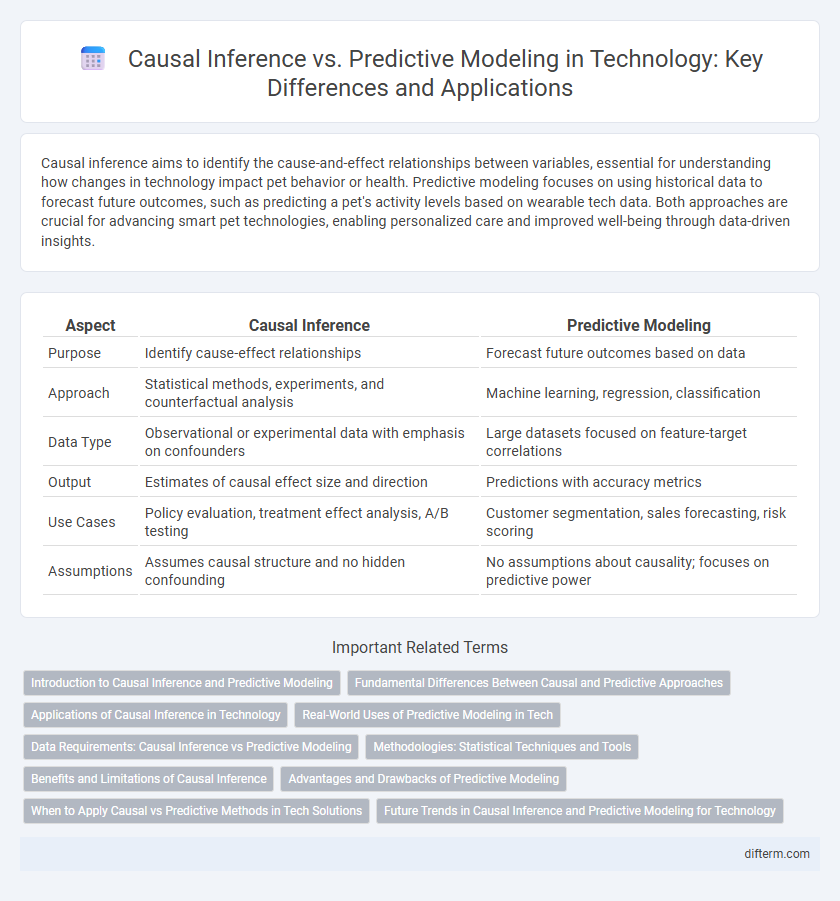Causal inference aims to identify the cause-and-effect relationships between variables, essential for understanding how changes in technology impact pet behavior or health. Predictive modeling focuses on using historical data to forecast future outcomes, such as predicting a pet's activity levels based on wearable tech data. Both approaches are crucial for advancing smart pet technologies, enabling personalized care and improved well-being through data-driven insights.
Table of Comparison
| Aspect | Causal Inference | Predictive Modeling |
|---|---|---|
| Purpose | Identify cause-effect relationships | Forecast future outcomes based on data |
| Approach | Statistical methods, experiments, and counterfactual analysis | Machine learning, regression, classification |
| Data Type | Observational or experimental data with emphasis on confounders | Large datasets focused on feature-target correlations |
| Output | Estimates of causal effect size and direction | Predictions with accuracy metrics |
| Use Cases | Policy evaluation, treatment effect analysis, A/B testing | Customer segmentation, sales forecasting, risk scoring |
| Assumptions | Assumes causal structure and no hidden confounding | No assumptions about causality; focuses on predictive power |
Introduction to Causal Inference and Predictive Modeling
Causal inference identifies cause-and-effect relationships by analyzing how changes in one variable impact others, using methods like randomized experiments and instrumental variables. Predictive modeling focuses on forecasting future outcomes based on patterns in historical data, employing algorithms such as regression, decision trees, and neural networks. Both approaches leverage statistical techniques but serve distinct purposes: causal inference guides decision-making by understanding mechanisms, whereas predictive modeling enhances accuracy in predictions.
Fundamental Differences Between Causal and Predictive Approaches
Causal inference aims to identify cause-and-effect relationships by analyzing how changes in one variable directly impact another, often using experimental or quasi-experimental designs to isolate these effects. Predictive modeling focuses on forecasting future outcomes based on patterns in historical data, emphasizing accuracy in prediction without necessarily understanding the underlying causal mechanisms. The fundamental difference lies in causal inference targeting explanation and intervention, while predictive modeling prioritizes prediction accuracy.
Applications of Causal Inference in Technology
Causal inference plays a critical role in technology by enabling precise decision-making through the identification of cause-and-effect relationships, which predictive modeling merely correlates. It is applied in personalization algorithms, A/B testing for software optimization, and improving recommendation systems by understanding the impact of interventions on user behavior. This approach enhances machine learning models by informing strategies that optimize user engagement and system performance based on causal insights rather than predictions alone.
Real-World Uses of Predictive Modeling in Tech
Predictive modeling in technology powers applications like fraud detection, personalized recommendations, and predictive maintenance by analyzing historical data to forecast future outcomes. Machine learning algorithms enhance the accuracy of predictions in real-time systems, improving user experiences and operational efficiency. Real-world implementations in tech companies leverage predictive models for customer behavior analysis, demand forecasting, and anomaly detection in cybersecurity.
Data Requirements: Causal Inference vs Predictive Modeling
Causal inference typically requires carefully designed datasets with clear treatment and control groups, ensuring confounding variables are accounted for to identify cause-effect relationships accurately. Predictive modeling relies on large and diverse datasets to train algorithms that can generalize well, prioritizing accuracy and pattern recognition over understanding underlying causal mechanisms. High-quality, well-structured data with explicit variable relationships is crucial for causal inference, while predictive models benefit from extensive labeled data and robust feature engineering.
Methodologies: Statistical Techniques and Tools
Causal inference relies on methodologies such as randomized controlled trials, propensity score matching, and instrumental variable analysis to identify cause-and-effect relationships by controlling for confounders. Predictive modeling employs machine learning algorithms including regression, decision trees, and neural networks to forecast future outcomes based on patterns in historical data. Tools like R, Python (with libraries such as scikit-learn and DoWhy), and specialized software like Stata and SAS facilitate both approaches by providing robust frameworks for statistical analysis and model validation.
Benefits and Limitations of Causal Inference
Causal inference enables understanding the underlying mechanisms and direct effects of interventions, providing actionable insights for decision-making in technology development. Its benefits include the ability to identify true cause-and-effect relationships, which helps avoid spurious correlations common in predictive modeling. However, causal inference relies heavily on assumptions about data and model structure, making it sensitive to biases and often requiring extensive experimental or quasi-experimental data for valid conclusions.
Advantages and Drawbacks of Predictive Modeling
Predictive modeling excels at identifying patterns and forecasting future outcomes by analyzing large datasets and incorporating machine learning algorithms, making it highly valuable for risk assessment, demand forecasting, and customer behavior prediction. However, it lacks the ability to determine causal relationships, which limits its effectiveness in understanding underlying mechanisms or informing policy decisions. The dependence on historical data also introduces biases and risks overfitting, reducing generalizability and interpretability across different contexts.
When to Apply Causal vs Predictive Methods in Tech Solutions
Causal inference is essential in technology when understanding the effect of interventions or changes on user behavior, such as evaluating the impact of a new feature rollout on engagement metrics. Predictive modeling excels in scenarios requiring accurate forecasts, like anticipating system failures, recommending content, or detecting fraud based on historical data patterns. Choosing between causal and predictive methods depends on whether the objective is explanation and insight or precise future predictions within tech solutions.
Future Trends in Causal Inference and Predictive Modeling for Technology
Advancements in causal inference emphasize interpretable AI models to uncover underlying cause-effect relationships, enabling more robust decision-making in technology applications such as recommendation systems and autonomous systems. Predictive modeling continues to leverage deep learning and big data analytics, enhancing real-time predictions with improved accuracy and scalability across industries. Emerging trends highlight the integration of causal inference with predictive techniques to create hybrid models that balance explainability and performance, driving innovation in AI-driven technological solutions.
Causal inference vs Predictive modeling Infographic

 difterm.com
difterm.com